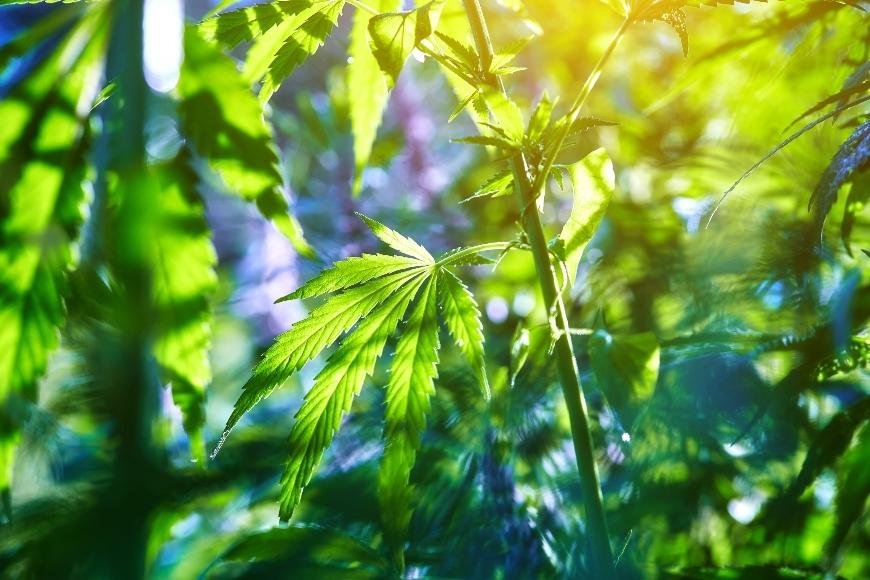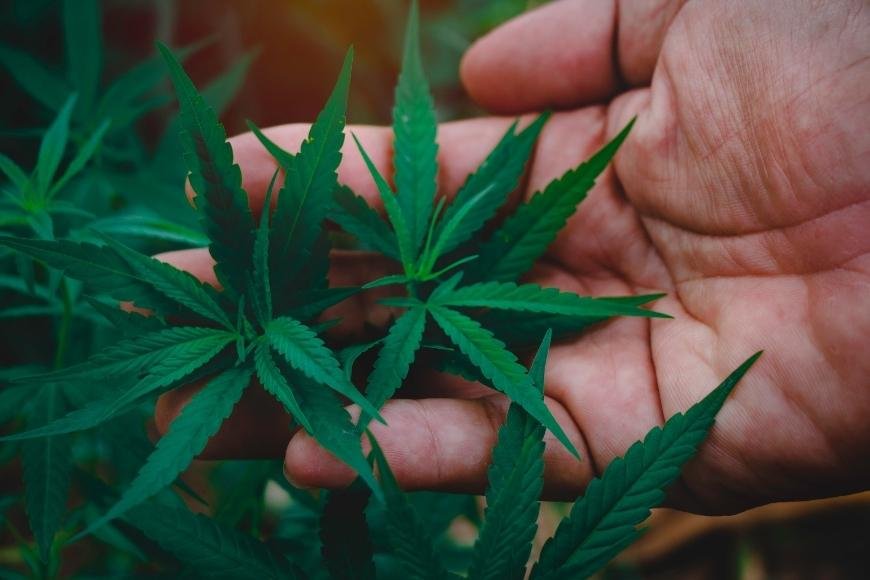How Does CO2 Affect Cannabis Plants?
Explore "How Does CO2 Affect Cannabis Plants?" - uncover growth, potency, ideal levels, enrichment methods & ventilation tips in our comprehensive guide.

How does CO2 affect cannabis plants? This is a question that many young adults, particularly those who grow and consume cannabis recreationally, often ponder. In this blog post, we will explore how CO2 impacts the growth and development of cannabis plants, from its sources to the benefits it offers.
We will begin by discussing what CO2 is, its sources, and the benefits it offers to growing cannabis. Subsequent to our initial discourse, we'll examine the various ways in which CO2 affects cannabis plants, from growth rate and yield potential to potency levels and other relevant factors.
Furthermore, we'll outline ideal CO2 levels for different stages of plant growth – from vegetative to flowering stages – before providing guidance on how to introduce additional CO2 into your grow room using generators or bottled sources. Finally, we'll address potential dangers associated with high concentrations of carbon dioxide and emphasize the importance of proper ventilation when working with increased levels of this natural gas.
By understanding how does CO2 affect cannabis plants at each stage of their life cycle can help you optimize your cultivation techniques for better results in terms of both quality and quantity.
Table of Contents:
- What is Carbon Dioxide (CO2)?
- Definition of CO2
- How Does CO2 Affect Cannabis Plants?
- What are the Ideal CO2 Levels for Cannabis Plants?
- How to Add CO2 to the Grow Room?
- Potential Dangers of High CO2 Concentrations and Proper Ventilation Requirements
- Frequently Asked Questions How Does Co2 Affect Cannabis Plants?
- Conclusion
What is Carbon Dioxide (CO2)?
Carbon dioxide (CO2) is an essential gas for the growth and development of plants, including cannabis, that naturally occurs in the environment. In this section, we will explore what CO2 is, its sources, and how it benefits cannabis plants.
Definition of CO2
CO2 is a trace gas present in Earth's atmosphere, consisting of one carbon atom bonded to two oxygen atoms at approximately 0.04% by volume. It exists in Earth's atmosphere as a trace gas at around 0.04% by volume. While it may be present in small amounts compared to other gases like nitrogen and oxygen, CO2 plays a crucial role in plant life through the process called photosynthesis.
Sources of CO2
- Natural processes: Volcanic eruptions, decomposition of organic matter by microbes or fungi,
- Ocean release: Dissolved carbon dioxide released from oceans into the atmosphere,
- Anthropogenic activities: Burning fossil fuels for energy production or transportation purposes.
Benefits of CO2 for Cannabis Plants
Cannabis plants require adequate levels of carbon dioxide during their growth cycle to thrive properly:
- Growth stimulation: Higher concentrations can boost photosynthesis rates leading to faster growth.
- Improved yield: Increased CO2 levels can result in larger, denser buds and higher overall yields.
- Enhanced stress tolerance: Elevated CO2 concentrations help plants cope better with environmental stresses such as heat or drought.
By understanding the role of carbon dioxide in photosynthesis, growers can capitalize on its influence to maximize cannabis plant growth, yield, and potency. Understanding how CO2 affects cannabis plants is key to maximizing your crop's potential.

How Does CO2 Affect Cannabis Plants?
By exploring the influence of carbon dioxide (CO2) on cannabis plants, we can gain insight into how it affects their growth, yield, potency and more to optimize your grow room environment. Understanding these impacts can help you optimize your grow room environment for maximum results.
Effects on Growth and Yield
Higher levels of CO2 have been shown to significantly increase the growth rate and overall yield of cannabis plants. This is because CO2 plays a crucial role in photosynthesis, which is the process by which plants convert light energy into chemical energy to fuel their growth. When there's more available CO2, photosynthesis becomes more efficient, leading to faster-growing plants with larger yields.
- Faster Growth: Elevated CO2 levels can speed up plant development during both vegetative and flowering stages.
- Larger Yields: An increased supply of carbon dioxide allows for better utilization of light resources resulting in higher biomass production - ultimately translating into bigger harvests.
Effects on Potency
Besides boosting growth rates and yields, enhanced levels of atmospheric carbon dioxide may also impact the potency or concentration of cannabinoids like THC (tetrahydrocannabinol) within cannabis flowers. Some research indicates that higher CO2 levels may result in increased cannabinoid concentrations, though further study is required to affirm these results. Nonetheless, optimizing CO2 levels in your grow room can potentially lead to more potent buds.
Other Factors Influenced by CO2 Levels
In addition to growth, yield, and potency, there are other factors influenced by the amount of carbon dioxide present in a cannabis plant's environment:
- Resilience: Higher levels of CO2 concentration may improve a plant's ability to withstand environmental stressors such as pests or diseases.
- Nutrient Uptake: Elevated concentrations can enhance nutrient uptake efficiency - meaning plants will be able to absorb nutrients from their growing medium more effectively.
- Water Use Efficiency: An increased rate of photosynthesis due to higher CO2 availability allows for better water use efficiency within the plant; this means that they require less water per unit of biomass produced.
It is evident that CO2 levels play a significant role in the development and yield of cannabis plants, making it imperative to understand what optimal ranges are for each phase of growth. Consequently, to guarantee successful cultivation, recognizing the ideal CO2 levels for each period of the plant's life cycle is a must. Moving forward, let us explore what these optimal ranges are during both vegetative and flowering stages.
What are the Ideal CO2 Levels for Cannabis Plants?
In this section, we will discuss the ideal carbon dioxide (CO2) levels for cannabis plants during their different growth stages. Understanding these optimal levels is crucial to maximize your plant's growth, yield, and potency.
Vegetative Stage
During the veg stage of a cannabis plant's life, its attention is on growing leaves and stems as opposed to buds or blooms. The ideal CO2 level during this stage ranges from 900 to 1,500 parts per million (ppm). This concentration is significantly higher than ambient air levels which typically contain around 400 ppm of CO2.
To achieve these desired concentrations in your grow room, you can use various methods such as CO2 supplementation techniques, including generators or bottled sources discussed later in this article.
Flowering Stage
At the flowering stage, cannabis plants produce buds packed with cannabinoids such as THC and CBD - elements that can cause psychoactive effects or potentially therapeutic advantages. During this phase, maintaining slightly lower CO2 levels between 800-1,200 ppm helps optimize bud development while ensuring healthy plant growth.
- Note: It's essential not to exceed 1,500 ppm since excessive amounts may lead to reduced yields due to poor nutrient uptake by the roots and possible toxic effects on your plants.
Maintaining appropriate CO2 concentrations throughout both vegetative and flowering stages requires careful monitoring using devices like digital sensors or handheld meters that provide accurate readings within seconds.
Remember that while increasing CO2 concentrations can significantly enhance your cannabis plants' growth and yield, it's crucial to strike a balance with other environmental factors such as temperature, humidity, and light intensity.
How to Add CO2 to the Grow Room?
If you want to boost your cannabis plants' growth and yield, adding extra CO2 can be a game-changer. In this section, we'll explore two popular methods of increasing CO2 levels in your grow room: generators and bottled sources. We'll also discuss how to monitor and regulate these levels for optimal results.
Generators and Bottled CO2 Sources
CO2 Generators: These devices produce carbon dioxide by burning propane or natural gas, making them an efficient way of raising the ambient CO2 concentration in your grow space. Ventilation and temperature control are essential when employing a CO2 generator, since it produces heat as an outcome.
Bottled CO2: Another option is using compressed carbon dioxide from bottles or tanks that are specifically designed for horticultural use. This method allows more precise control over the amount of added CO2 but may require additional equipment like regulators, solenoids valves, timers, and diffusers to distribute it evenly throughout the growing area. Be cautious when handling high-pressure cylinders; always follow safety guidelines provided by manufacturers.
Monitoring and Regulating CO2 Levels
- Digital Controllers: To ensure proper distribution of supplemental carbon dioxide without exceeding safe limits (1500-2000 ppm), invest in digital controllers that measure and adjust CO2 levels in real-time. These devices can be programmed to maintain the desired concentration, ensuring optimal growth conditions for your cannabis plants (read more about digital controllers here).
- CO2 Timers: If you're using bottled CO2, timers can help regulate its release by opening and closing solenoid valves at specific intervals. This method is less precise than digital controllers but still effective when used correctly. Experiment with different settings to find what works best for your grow room.
- Air Circulation: Proper air circulation ensures that added carbon dioxide reaches all areas of your growing space evenly. Use oscillating fans or duct systems to distribute CO2 throughout the room, making sure not to blow it directly onto plants as this may cause stress (learn more about proper ventilation techniques here).
Adding CO2 to the grow room can be done through generators or bottled sources, and it is important to monitor and regulate levels. Nevertheless, if not appropriately ventilated, elevated amounts of CO2 can pose potential risks; thus, suitable ventilation should be accounted for when incorporating CO2 into a marijuana growth chamber.

Potential Dangers of High CO2 Concentrations and Proper Ventilation Requirements
While a rise in CO2 can be advantageous for cannabis plants, it is critical to recognize the potential perils connected with high concentrations and understand the significance of appropriate ventilation.
Risks of High CO2 Concentrations
Excessive amounts of carbon dioxide can pose risks not only to your cannabis plants but also to you as a grower. Some potential hazards include:
- Oxygen deprivation: In an enclosed space with elevated CO2 levels, oxygen concentration may decrease, leading to suffocation for both humans and plants if not adequately ventilated. It is crucial to monitor the air quality within your grow room regularly.
- Poor plant health: Extremely high levels of CO2 can cause stress on cannabis plants, resulting in stunted growth or even death. Make sure you maintain appropriate concentrations throughout each stage of growth.
- Insect infestations: Increased carbon dioxide may attract pests like spider mites that thrive in environments with higher-than-normal concentrations. Regularly inspect your plants for signs of infestation and take necessary precautions such as introducing beneficial insects or using organic pesticides.
- Safety hazards: If you're using CO2 generators that burn propane or natural gas, there's a risk of fire or explosion if not properly maintained and operated. Always follow the manufacturer's guidelines for safe use.
Importance of Proper Ventilation
Maintaining proper ventilation in your grow room is essential to avoid the risks associated with high CO2 concentrations. Here are some tips to ensure adequate airflow and air exchange:
- Install exhaust fans: Use powerful exhaust fans to remove excess heat, humidity, and stale air from your grow space. Make sure they are correctly sized according to the volume of your room.
- Add intake vents: Intake vents allow fresh air containing oxygen and ambient levels of CO2 to enter the grow room, helping maintain optimal conditions for plant growth. Ensure these vents are placed near floor level on the opposite side of your exhaust fan(s) for efficient circulation.
- Oscillating fans: Place oscillating fans within your grow space to help evenly distribute both temperature and CO2 throughout the area while also strengthening plant stems through gentle movement. Avoid pointing them directly at plants as this can cause windburn.
- Air filters & scrubbers: Using carbon filters or air scrubbers can help eliminate odors produced by cannabis plants while also purifying the air of potential contaminants. This is especially important if you're growing in a shared living space or want to maintain discretion.
By understanding the risks associated with high CO2 concentrations and ensuring proper ventilation, you can create an optimal environment for your cannabis plants while maintaining safety and efficiency within your grow room.
Frequently Asked Questions How Does CO2 Affect Cannabis Plants?
How does CO2 affect cannabis plants?
CO2 plays a crucial role in the photosynthesis process, enabling cannabis plants to produce energy and grow. Higher levels of CO2 can lead to increased growth rates, higher yields, and improved potency. However, maintaining optimal CO2 levels is essential for achieving these benefits.
How much CO2 is bad for cannabis?
Excessive amounts of CO2 can be harmful to cannabis plants. Generally, concentrations above 1,500 ppm are considered too high and may cause reduced plant growth or other negative effects. It's important to monitor and regulate the levels of CO2 in your grow room to ensure healthy plant development.
How much does CO2 increase cannabis yield?
Supplementing with additional CO2 has been shown to potentially increase yields by up to 20-30%. However, this depends on various factors such as strain type, growing conditions (light intensity), nutrient availability & overall care provided during cultivation.
When should you stop using CO2 during flowering?
It's recommended that growers discontinue adding supplemental carbon dioxide about two weeks before harvest time. This allows the plants enough time without excess C02 exposure which could negatively impact their flavor profile & final product quality.
Conclusion
In the end, it is essential for cultivators of cannabis to comprehend how CO2 impacts their plants and what optimal levels are. By understanding this information, they can ensure that their plants have enough carbon dioxide to thrive while avoiding any potential risks associated with high concentrations. By implementing the necessary measures to maintain adequate levels of CO2, growers can be assured that their cannabis crop will reach its maximum potential with minimal risk. Ultimately, knowing the answer to "does CO2 affect cannabis plants?" is key for successful cultivation.
























































































































